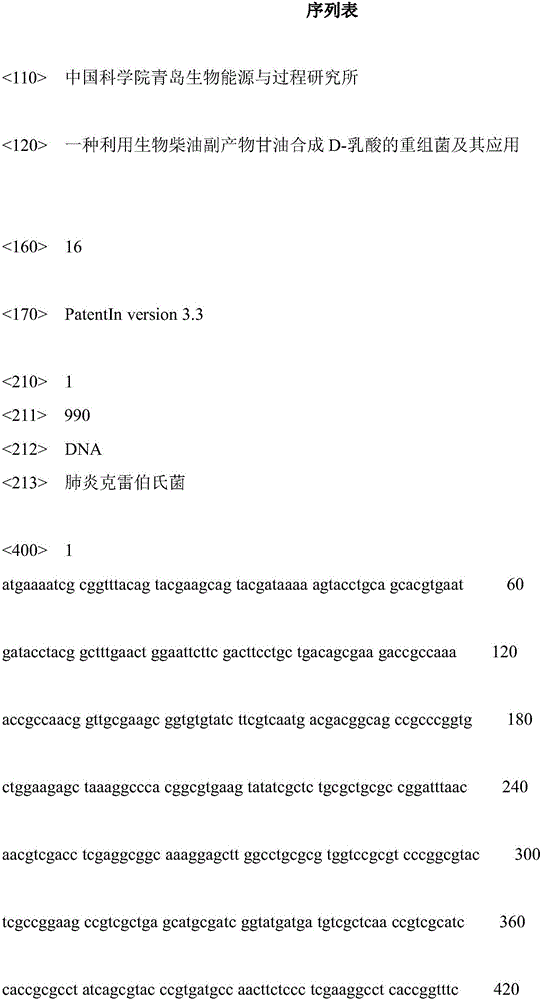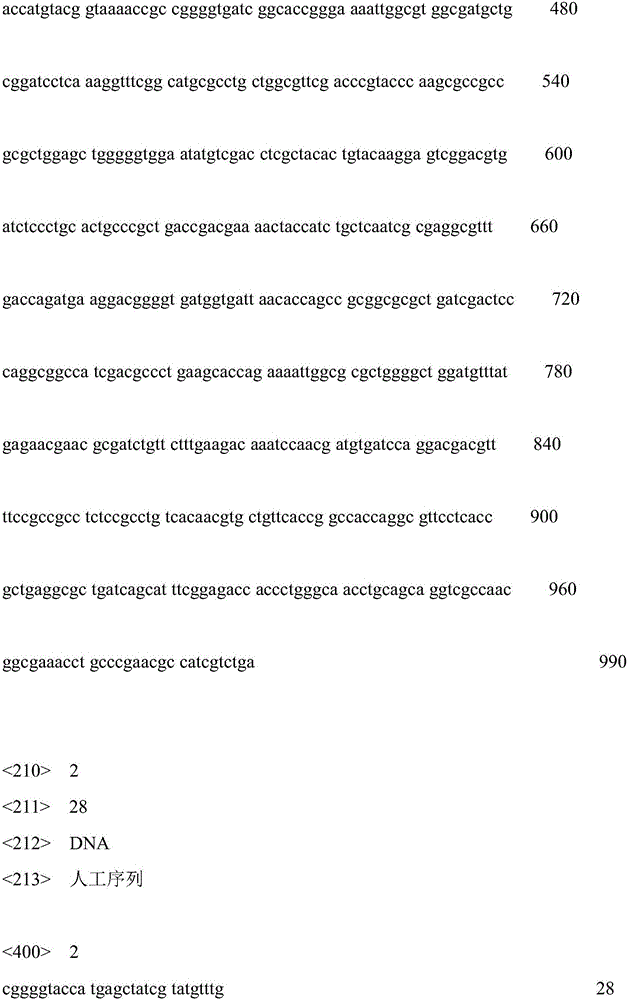Recombinant bacterium for synthesizing D-lactic acid by adopting biodiesel by-product, namely, glycerol and applications of recombinant bacterium
A biodiesel and recombinant bacteria technology, applied in the field of genetic engineering, can solve the problem of high raw material prices, achieve the effects of improving product conversion rate, reducing production costs, and improving fermentation conditions
- Summary
- Abstract
- Description
- Claims
- Application Information
AI Technical Summary
Problems solved by technology
Method used
Image
Examples
Embodiment 1
[0046] The knockout of embodiment 1 gene
[0047] In this example, primers were designed using about 500 base fragments upstream and downstream of the 1,3-propanediol dehydrogenase gene (dhaT) (Gene ID: 7946507) of the wild strain of Klebsiella pneumoniae (K. penumoniae) as a template 1,3-propanediol dehydrogenase gene (dhaT) upstream and downstream fragments were amplified by PCR respectively, and then the target gene fragment was recovered by using a recovery kit.
[0048] The upstream amplification primer sequence is: Kp-dhaT-Up-5': 5'-CGGGGTACCATGAGCTATCGTAT GTTTG-3' and Kp-dhaT-Up-3': 5'-GATGAGGCGGATCGCCTGCGATCACAAACTT CACTTTG-3'; the downstream amplification primer sequence is Kp -dhaT-Down-5': 5'-CAAAGTGAAGTTTGTGATCGCAGGCGATCCGCCTCATC-3' and Kp-dhaT-Down-3': 5'-GTCCGAGCTCTCAGAATGCCTGGCGGAAAATCG-3'.
[0049] After recovering the amplified fragment above, use the recovered fragment as a template to perform bridge PCR to obtain the fragment ΔdhaT for knocking out the 1,3-...
Embodiment 2
[0054] The cloning of embodiment 2 exogenous gene
[0055] In this example, the D-lactate dehydrogenase gene (ldhA) (Gene ID: 6938538) derived from K.pneumoniae was obtained, which was obtained by PCR amplification using K.pneumoniae as a template (primer: 5'-CGAGCTCTATAATCACTGGAGAAAAGT- 3' and 5'-GCTCTAGAGAATCAGACGATGGCGTTCG-3'), and then use the recovery kit to recover the target fragment.
Embodiment 3
[0056] The construction of embodiment 3 expression vector
[0057] The D-lactate dehydrogenase ldhA gene fragment obtained in Example 2 and the plasmid pBAD18 were digested with SacI and XbaI, and the digested products were recovered, and then ligated. The vector and the ldhA gene fragment were in a molar ratio of 1:5, 16 ℃ for more than 6h, the ligation product was transformed into E.coliDH5α, and then coated with 100μg·mL -1 On the LB solid plate of kanamycin, positive clones were screened by PCR. After the recombinant plasmid pBAD18-ldhA was extracted from the positive clone, it was identified by restriction enzyme digestion and sequencing, and was used to overexpress D-lactate dehydrogenase.
PUM
| Property | Measurement | Unit |
|---|---|---|
| optical purity | aaaaa | aaaaa |
Abstract
Description
Claims
Application Information
 Login to View More
Login to View More - Generate Ideas
- Intellectual Property
- Life Sciences
- Materials
- Tech Scout
- Unparalleled Data Quality
- Higher Quality Content
- 60% Fewer Hallucinations
Browse by: Latest US Patents, China's latest patents, Technical Efficacy Thesaurus, Application Domain, Technology Topic, Popular Technical Reports.
© 2025 PatSnap. All rights reserved.Legal|Privacy policy|Modern Slavery Act Transparency Statement|Sitemap|About US| Contact US: help@patsnap.com



